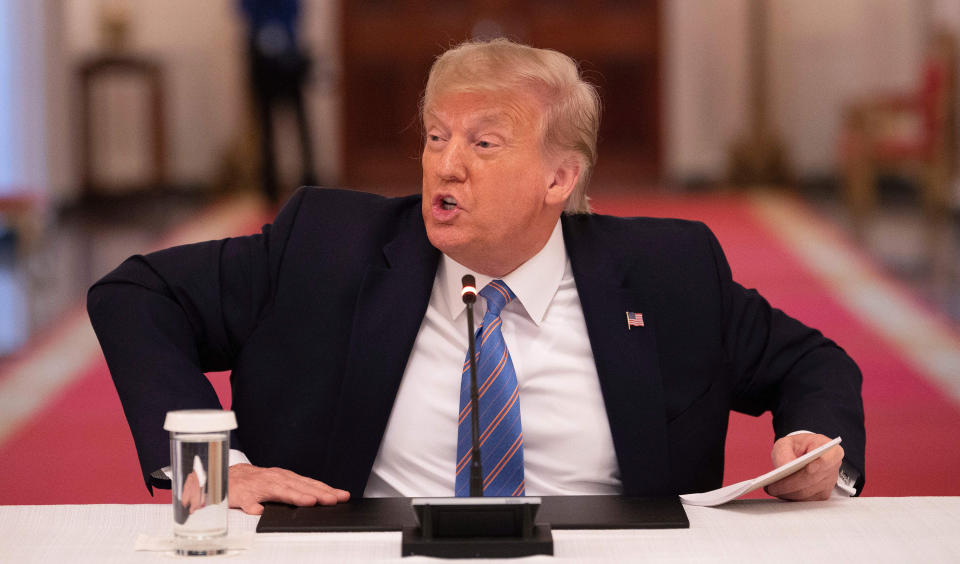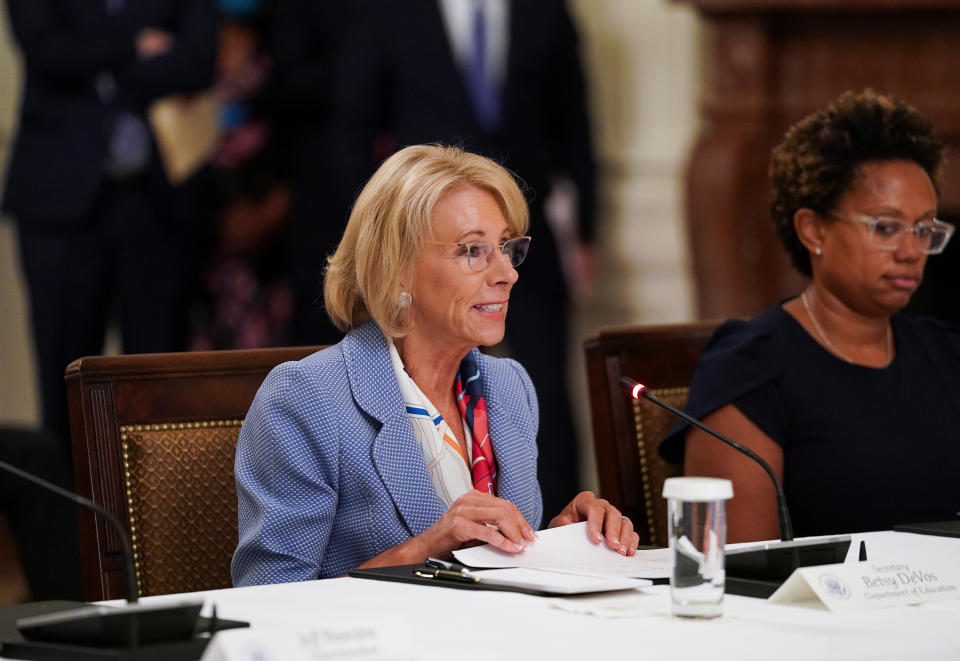White House pushes schools to open their doors on schedule
WASHINGTON — The Trump administration deployed some of its top officials — including the president and the vice president and their respective wives — to press school districts to reopen on their regular schedules for in-person instruction. The call came even as the coronavirus surges across parts of the nation.
An even greater surge of cases is predicted by some health experts for the fall, when it could coincide with the seasonal flu.
“To open up America again, we need to open up our schools again,” said Vice President Mike Pence, speaking from the State Floor of the White House, where he and others convened for an event billed as the “National Dialogue on Safely Reopening America’s Schools.”
His remarks followed a brief statement from first lady Melania Trump, who rarely speaks in public and whose presence seemed to indicate how critical the issue is to a president eager to be seen as leading the nation after a brutally difficult June. He has precious little time to do so before November’s presidential election.
“When children are out of school, they are missing more than just time in the classroom,” the first lady said. “They are missing the laughter of their friends, learning from their teachers and the joy of recess and play.” She said the situation could be even worse for children with disabilities and children whose home situations are unsafe. After she finished her remarks, Pence urged the attendees to applaud the usually taciturn presidential spouse.
Pence later reiterated the administration’s argument to Bret Baier of Fox News, the favored news outlet of Trump and his most ardent supporters. But under questioning from Baier, Pence admitted that the federal government had limited capacity to “pressure” state education departments to mandate that schools open their doors.
Pence cited the “overwhelming opinion of the American people.” Opinion is, in fact, quite divided on whether schools should reopen to physical instruction and continue with distance learning.

President Trump made his own position clear on Monday evening, via his favorite communications medium. “SCHOOLS MUST OPEN IN THE FALL!!,” he wrote on Twitter. Right around the time that message was sent, Florida announced that it would order all schools open for five days of instruction per week. Coming from the nation’s third most populous state, that announcement was bound to have national repercussions.
In a call with reporters on Tuesday morning, senior administration officials would not say whether Florida had consulted the White House in crafting its reopening plan, which has been criticized by some for a lack of clarity and specificity. Incomplete though Florida’s plan may be, the Trump administration clearly wants other states to start taking similar steps. During the press call, a senior administration official implied that states that hesitate in reopening schools could lose out on future rounds of federal funding.
Speaking later to Yahoo News, that same official declined to elaborate. “There’s a lot of theoreticals you could throw out there” about how the federal government could reward states for reopening schools or, conversely, punish them for not doing so. “The starting premise should be opening up,” he said.
Pence made the same point on a call with governors, praising Gov. Gretchen Whitmer of Michigan — a Democrat who became a frequent Trump target throughout the spring — for her school reopening plan. Tiffany Brown, a spokeswoman for Whitmer, called on the Trump administration to“step up with a national mask-up campaign” that would make reopening easier. Such a campaign is unlikely, with White House chief of staff Mark Meadows saying only days before that there would be no national guidance on face coverings.
One person who listened to the call said the discussion was generally productive until Secretary of Education Betsy DeVos began to attack districts she believed were still intending to hold online classes next fall. The person who described the call to Yahoo News — and who would only speak about the call’s contents on the condition of anonymity — believed that DeVos’s true target was teachers’ unions.
Those unions hold enormous power, in particular in states controlled by Democrats. In some of the nation’s largest states, including Texas and California, unions have resisted returning to in-classroom instruction.
“[DeVos] delivered a clear message that all of America’s students deserve a full-time education,” Education Department spokeswoman Angela Morabito told Yahoo News. “Anyone who feels ‘attacked’ by that message should look in the mirror and ask if they’re really putting the needs of students first.”
Randi Weingarten, head of the powerful American Federation of Teachers union, gave the event — and the entire reopening push — a less-than-favorable review. “They don’t help. They don’t do anything,” she said of the administration, wondering why no detailed reopening plans or provisions had been made. “It’s pathetic.”
Weingarten, who previously headed the United Federation of Teachers, which represents New York City educators, noted that the White House event did not include any public school teachers. She reserved particular scorn for DeVos, a longtime champion of private, religious and charter schools. “Every moment she opens her mouth, it shows how little she knows about public schools,” Weingarten said of DeVos.
But intransigence over the issue could result in a backlash against the unions, as anger over school closures appears to be building.
Pressure to resume classes is bolstered by a growing belief among medical experts that schools are unlikely to be a significant source of viral transmission. Among the participants at Tuesday’s event at the White House was Dr. Sally Goza, head of the American Association of Pediatrics. The influential group recently issued a much cited guidance that counseled that “all policy considerations for the coming school year should start with a goal of having students physically present in school.”

Dr. Robert Redfield, director of Centers for Disease Control and Prevention, said on Tuesday that it had never been CDC’s advice for school districts to close last spring, or for those districts to remain closed into the autumn.
“CDC encourages all schools — all schools — to do what they need to reopen,” he said at the White House on Tuesday. At the same time, he counseled schools to “anticipate that COVID-19 cases will, in fact, occur.”
Israel, which reopened its schools in May, had to shutter some of them in June after an outbreak of coronavirus infections. That country’s experience with school reopening has been regarded by some as a cautionary tale. Somewhat more than half of Americans are worried about schools reopening in the fall.
At the same time, there is broad recognition across the political spectrum that schools are an economic and social linchpin. As long as schools remain closed, many parents will be saddled with childcare responsibilities. Children in low-income communities without ready Internet access will continue to fall further behind their wealthier peers.
The benefits of reopening schools outweigh the risks, the administration has concluded. It must now convey to parents, students and educators that reopening is safe, but also not without dangers. “I’m not sure anybody’s got this completely figured out yet,” Tennessee health director Dr. Lisa Piercey said at the White House event. “And no school district has this completely figured out yet. And I guarantee there will be something that happens that’s unexpected.”
Weingarten said Florida’s plan to return to a full five-day schedule was unrealistic. “It’s not possible to do five days a week,” the union leader said. Her union estimates that it would cost an additional $2,300 per child to properly equip public schools to safely reopen.
“I don’t want teachers or students getting sick,” Weingarten said, predicting that the new year would open with a “hybrid” instruction model.
Congress is soon expected to take up a new round of coronavirus relief funding, which is likely to include funds that states can use for school relief. Speaking to Yahoo News, the senior administration official noted that $150 billion in what he called “very flexible” funding already has been made available to states, along with $13 billion specifically for schools. The official expressed confidence that schools will figure out how to hold classes safely, adding that “educators are, at their core, problem solvers.”
Several states are suing DeVos, charging her with seeking to funnel money intended for public schools to private ones instead.
The administration appears to be banking on a combination of financial incentives and political pressure to influence states and municipalities in their decision making. Its thinking was summarized on Tuesday afternoon by Secretary of Health and Human Services Alex Azar with three simple words: “We must reopen.”
_____
Read more from Yahoo News:



